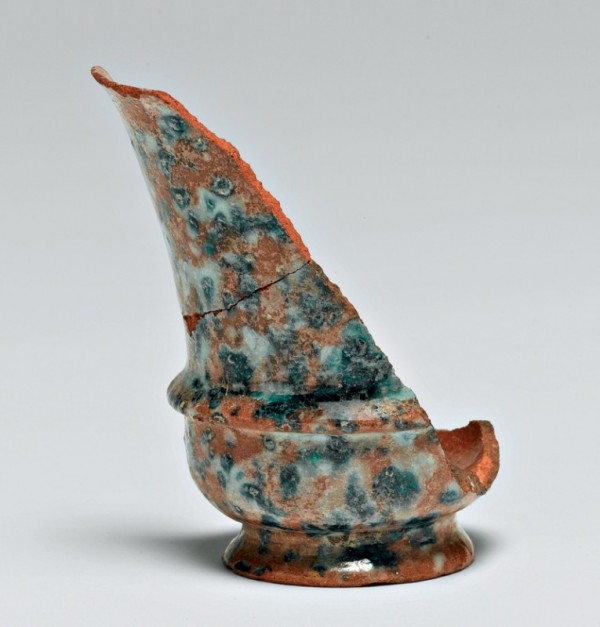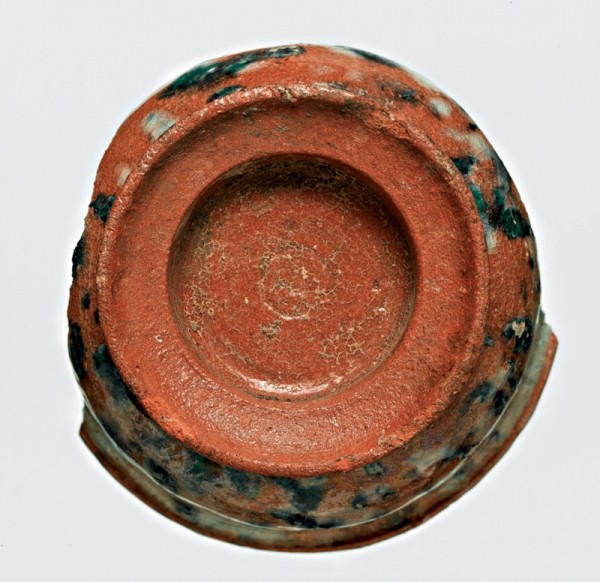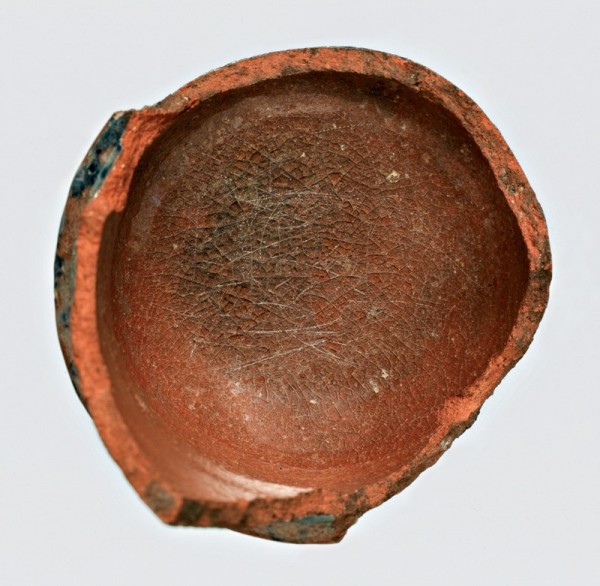
Capuchine, ca. 1685–1720, found in Bishopsgate, London, England. Red earthenware with spattered tin glaze decoration. H. 3". (All photos by Andy Chopping, Museum of London Archaeology Service, unless otherwise noted.)

Detail of the base of the redware capuchine illustrated in fig. 1, showing the finely turned foot rim. D. 1 1/2".

Detail of the inside of the capuchine illustrated in fig. 1, showing glaze pooling and crazing.

Capuchine, John Dwight, Fulham, London, ca. 1690–1700. Salt-glazed stoneware. H. 3". (Chipstone Foundation; photo, Gavin Ashworth.)
Recent archaeological excavations just outside the City of London, England, have brought to light fragments of a small cup made in fine red earthenware and decorated in a distinctive and unusual fashion. The cup was found in the course of excavations by the Museum of London Archaeology Service (MoLAS) on the site of Bishopsgate Goods Yard, as part of a new urban railway.[1] This note is prompted by the close comparisons between the Bishopsgate cup and mugs recovered from excavations in Virginia.
The London find is made in the form of a capuchine, a small handled cup with an elegant, bell-shaped profile (fig. 1). A pronounced cordon, very slightly undercut, is positioned low on the body, with a corresponding shallow groove inside. The flared foot is carefully shaped with a relatively wide, recessed foot rim, which is gently hollowed underneath (fig. 2); the handle is now missing. The vessel is thin-walled and finely potted, thrown and subsequently turned, thereby exhibiting a lightness of touch that is uncharacteristic of the red earthenware body. The fabric is evenly fired and brick red in color throughout, with abundant, fine, rounded quartz inclusions, colorless, white, and gray; moderate to abundant, ill-sorted, sub-angular quartz; sparse iron-rich compound; and calcareous inclusions. Without chemical analysis, which will be carried out in due course, the source is difficult to pinpoint, although macroscopic and microscopic examination at x20 magnification suggests a close similarity with redwares made in the London area.
The capuchine has an overall clear lead glaze, which has pooled inside the base and developed a fine network of crazing (fig. 3). Outside, the vessel has a highly individual form of splashed or spattered decoration, giving a two-tone, marbled effect over the red-brown body. It seems that an attempt was made to create the appearance of delftware by flicking or spattering cobalt with the thumb from a stiff brush onto an external coating of white tin glaze. The glaze has crawled into blobs during the second firing, with the cobalt separating.[2] Alternatively, the white tin glaze as well as the cobalt may have been spattered. Inside, the cup is completely plain, appearing reddish brown under the clear glaze.
The form of the capuchine, which was to develop into the standard coffee and chocolate cup of the later eighteenth century, is unknown in London-area red earthenwares, which were devoted almost entirely to the production of heavy-duty, utilitarian vessels for the kitchen and storeroom, as well as for industrial use, such as sugar refining. The term was applied to vessels of this form at least as early as circa 1700, as shown by James Morley’s Nottingham trade card on which a comparable example is illustrated in stoneware with pierced decoration.[3] Cups closely similar in shape were made at John Dwight’s Fulham Pottery (fig. 4) in brown salt-glazed stoneware, although they have a different form of base, with no foot rim.[4] There is no evidence that Dwight ever made earthenware, but there are examples of stoneware from the Fulham excavations decorated in imitation of cobalt- and manganese-dusted London delftware of the mid-seventeenth century.[5] Another possible inspiration for the appearance of the decoration, and one that would have been less “old-fashioned,” is a relatively uncommon late-seventeenth-century group of delftware vessels decorated in bleu de Nevers or bleu persan, with an overall external cobalt-blue glaze covered with random splotches of white.[6] The effect was created differently from spattering and is generally rather clumsier in appearance.
Vessels of capuchine form are known in London delftware made at the turn of the seventeenth–eighteenth century, but they are rare finds and no known examples have splashed or spattered decoration.[7] Cups with a similar shape and proportions but without the characteristic cordon were also made in delftware at the same date, and it has long been thought that they were originally designed for drinking coffee or chocolate, as suggested by contemporaneous pictorial evidence.[8] Other examples are known in brown salt-glazed Staffordshire stoneware circa 1700, and in white salt-glazed stoneware dating to the second quarter of the eighteenth century.[9]
The cup was found in a large context dated to circa 1700–1720 that included a range of fabrics and forms in widespread use throughout the London area during the late seventeenth to early eighteenth centuries. London-area redwares of the usual, utilitarian kind dominate, alongside Surrey-Hampshire border wares and delftware in a variety of decorative styles typical of the period. The context appears to represent the dumping of domestic refuse over several decades and dates from a time of increasing urbanization, with a number of different properties identified on the site and evidence for industrial activity in the form of sugar refining.[10] The dating of the context fits well with that of the parallels for the capuchine form cited above, and the other ceramics present in the same group give some idea of the everyday setting in which such a cup would have belonged.
The Bishopsgate capuchine represents something of a fusion of influences from different ceramic industries, marrying a shape that appears to have been developed in stoneware at the end of the seventeenth century with decoration apparently inspired by mid-seventeenth-century delftware, in a red earthenware fabric usually reserved for kitchen wares. The fine crafting of the cup elevates it above the more mundane forms made in the redware pottery industries of the London area and southeast England, and it is the only example of its kind to date to have been identified in London excavations, a unique combination of fabric, form, and decoration. There are, however, some striking parallels from sites excavated in Virginia. Fragments of two fine red earthenware canns with spattered decoration comparable to that of the London capuchine have been identified on the William Drummond plantation site in James City County, with sherds from four more recorded on nearby sites.[11] The form is one that was made in stoneware by John Dwight after circa 1685, and the skill with which the vessels were made, with their thin, lathe-turned walls, may suggest a link of some kind with Fulham, even though Dwight did not make earthenware. This possible link is further reinforced by the Bishopsgate capuchine, a form that was also made at Fulham. Merry Outlaw raises the possibility that the spattered earthenware canns were made by another London pottery as a result of “stealing” Dwight’s secrets, one of the many patent infringements that caused him considerable vexation.[12] Since a Fulham source is not indicated, this seems a plausible working hypothesis, borne out by the experimental appearance of the recorded finds.
The question remains why any potter should have thought it worthwhile to experiment with making fashionable, lathe-turned drinking vessels in humble red earthenware and then trying to decorate them with tin glaze. The effect of the cobalt-spattered glaze is not disastrous, even though it might not have been what the potter intended. Perhaps the cup was an attempt to find a ceramic body that was better able to withstand near-boiling water than delftware, different in fabric but trying to look the part. While the find is unique in London to date, the fact that at least six canns made in a similar fabric and with almost identical decoration found their way to Virginia suggests that this experimental ware was considered good enough to try out in the colonies if not in the capital.
ACKNOWLEDGMENTS
The Bishopsgate excavations, ongoing analysis, and publication are being generously funded by Transport for London, with thanks to Jon Colclough (TFL) and Stephen Haynes (Arup) for their interest and support. I am most grateful to Chris Green for his thoughts on the origins of the London capuchine; to my colleagues at MoLAS, Lyn Blackmore, Nigel Jeffries, and Lucy Whittingham, and to Hugo Blake and Jonathan Horne for further comments. I am also grateful to Nicky Powell, post-excavation manager, for her support.
Jacqueline Pearce, Specialist in Medieval and Later Pottery, Museum of London Archaeology Service; jpearce@molas.org.uk
Museum of London site code BGX05, context 1633. The site is situated in Hackney/Tower Hamlets and is part of the Transport for London, London Overground, East London Line Project. Full data can be obtained on request from MoLAS, Mortimer Wheeler House, 46 Eagle Wharf Road, London N1 7ED, U.K.
Chris Green, personal communication, February 2008.
Robin Hildyard, Browne Muggs: English Brown Stoneware, exh. cat. (London: Victoria and Albert Museum, 1985), p. 10.
Chris Green, John Dwight’s Fulham Pottery: Excavations 1971–79 (London: English Heritage, 1999), pp. 123–24, fig. 100, nos. 235, 236.
Ibid., pp. 106–7, fig. 88, no. 134. Compare the decoration with delftware illustrated in Ivor Noël Hume, Early English Delftware from London and Virginia, Colonial Williamsburg Occasional Papers in Archaeology 2 (Williamsburg, Va.: Colonial Williamsburg Foundation, 1977), pls. 23, 25.
For example, Michael Archer, Delftware: The Tin-Glazed Earthenware of the British Isles (London: Stationery Office, in association with the Victoria and Albert Museum, 1997), p. 247, C11.
Ibid., p. 349, pl. 216, H2.
Frank Britton, London Delftware (London: Jonathan Horne Publications, 1987); see also John C. Austin, British Delftware at Williamsburg, Williamsburg Decorative Arts Series (Williamsburg, Va.: Colonial Williamsburg Foundation, in association with Jonathan Horne Publications, 1994), no. 133. Archer, Delftware, p. 349.
Hildyard, Browne Muggs, nos. 345, 346; Diana Edwards and Rodney Hampson, White Salt-Glazed Stoneware of the British Isles (Woodbridge, Suffolk, Eng.: Antique Collectors’ Club, 2005), pls. 34, 172, fig. 155.
Aaron Birchenough, “A Brief Summary of the Excavations at Bishopsgate Goods Yard (East London Line Extension Project),” unpublished report, MoLAS.
Merry Outlaw, “A Collection of Curious ‘Canns,’” in Ceramics in America, edited by Robert Hunter (Hanover, N.H.: University Press of New England for the Chipstone Foundation, 2002), pp. 206–9.
Ibid., p. 208.
